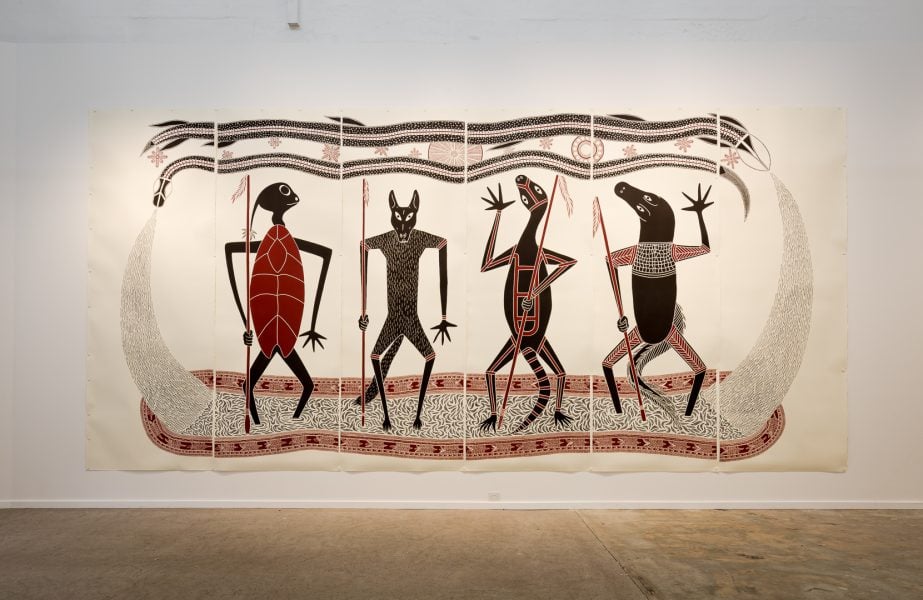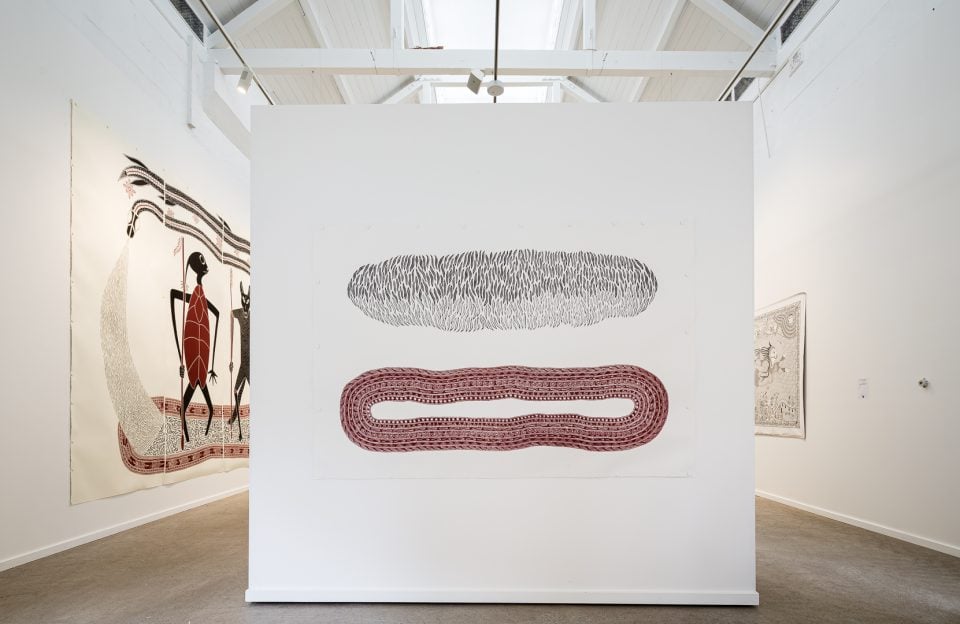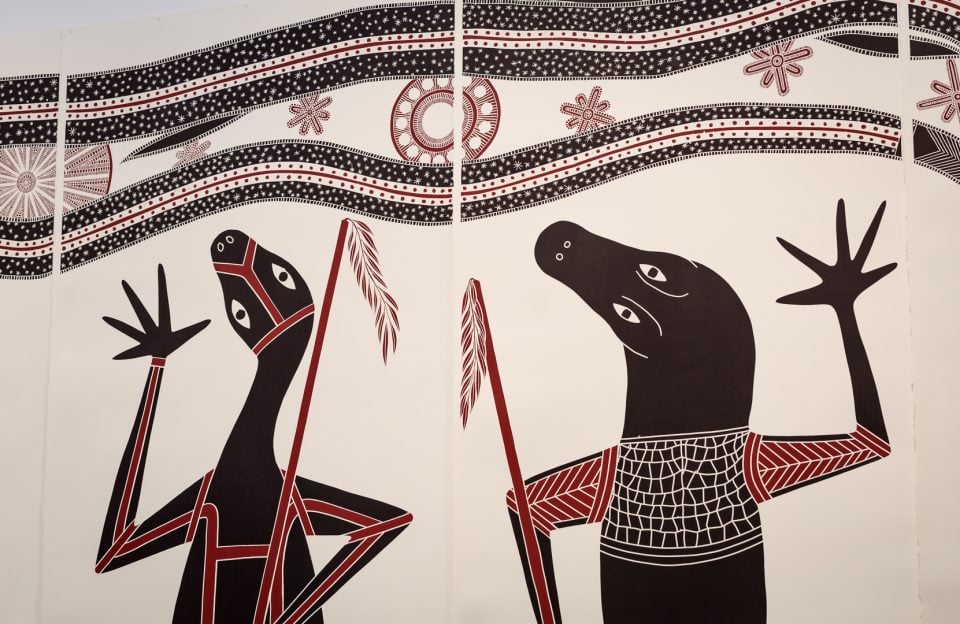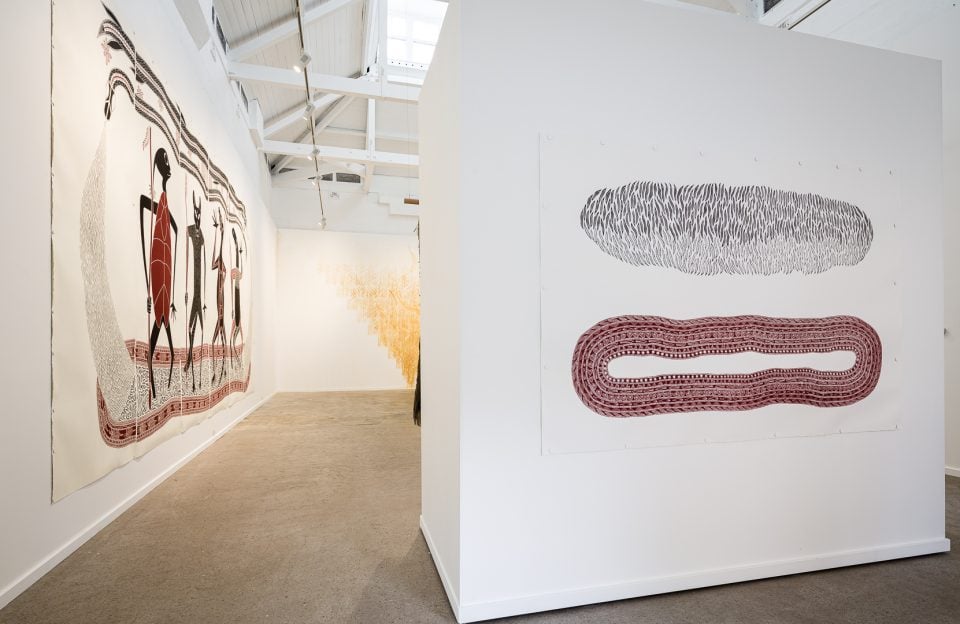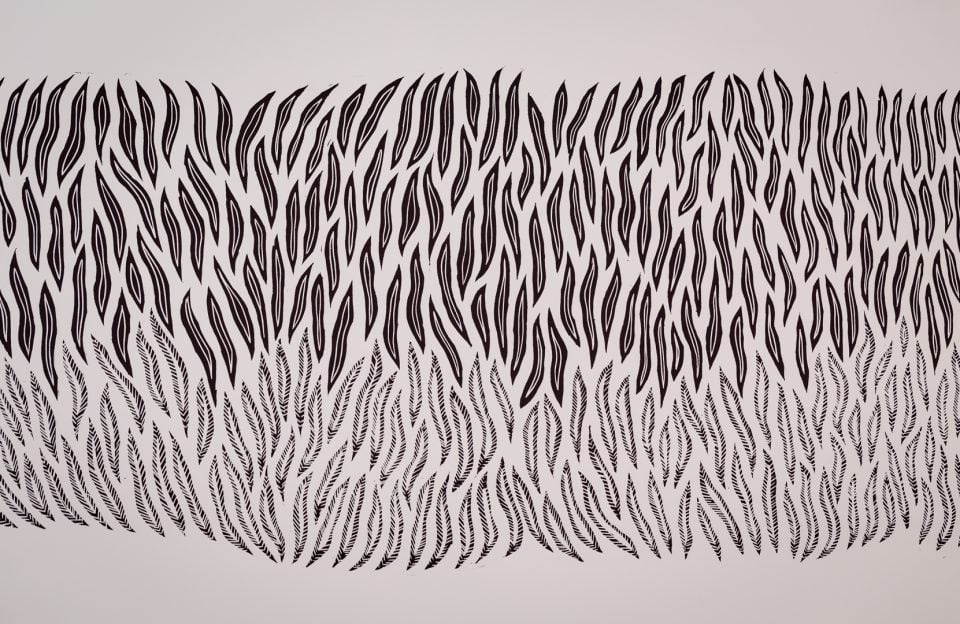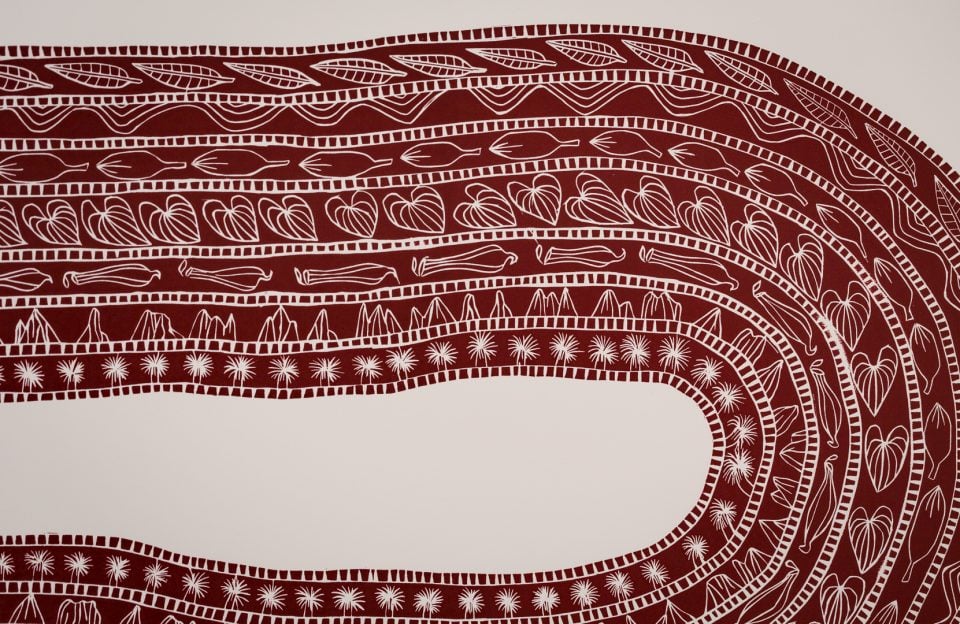Athumu Paypa Adthinhuunamu (my birth certificate), 2022
vinyl-cut prints on paper
Athumu Paypa Adthinhuunamu (my birth certificate), 2022
audio
duration TBC
Courtesy the artist & Onespace Gallery
Commissioned by the Biennale of Sydney with generous assistance from Arts Queensland
Ayarra, 2021
vinyl-cut print on paper
Edition of 5 + 2AP
Courtesy the artist & Onespace Gallery
Commissioned by the Biennale of Sydney with generous assistance from Arts Queensland
Teho Ropeyarn’s vinyl cut prints are grounded in his desire to maintain strong connections to people, culture and place. Referencing his Injinoo heritage, they unite Aboriginal and Torres Strait Islander designs and draw attention to the importance of transmitting cultural knowledge across generations. The bold shapes and delicately cut contours in his work, reference Injinoo culture and its connection to water – flowing continuously, vital and interdependent.
Ropeyarn spent time on Country to make his new works for the 23rd Biennale of Sydney:
‘I have just returned from Injinoo filming the traditional lands of the four clan groups that make up the Injinoo people. I wanted to include Injinoo Ikya language in my work, chanting, singing, and spoken words. This is something that is important to me for the survival of language, and the Pama Language Centre has been working with our Elders back home to bring language into the community. We don’t have any fluent language speakers anymore they have passed away. The Language Group is teaching people back in community to speak Ikya fluently. The revitalisation of language being spoken into Country again, gives life to Country.’
Teho Ropeyarn, Artist statement 2022
Ropeyarn’s print Ayarra (rainy season) 2021 relates to the seasonality of Cape York and the cyclical relationship between water and land.
Commissioned by the Biennale of Sydney with generous assistance from Arts Queensland
ARTIST STATEMENT
Water is integral to the Injinoo people, present in our creation stories as it is in my nation’s identity. I am a descendent of the Seven Rivers people of the Angkamuthi Nation, northwestern Cape York. The seven rivers that define the Angkamuthi land mass are Jardine, MacDonald, Skardon, Doughboy, Ducie and Jackson Rivers and Crystal Creek. Our totem is uyinthayn (freshwater turtle), ikamba (crocodile) and akaymu (dingo). The rivers run into the Gulf of Carpentaria and Arafura Sea.
Our creation stories are led by two umbah, great carpet snakes who formed the Great Dividing Range by digging for water. The lands were formed by the movement of their bodies; they created springs, creeks and rivers using their tails which drilled into the earth.
The most significant watercourse on our country is the Jardine River, Queensland’s longest perennial river system. The river traverses lands of all four clan groups that make up the Injinoo people: Gudang (north), Yadhaykana (east), Atambaya (south central), Angkamuthi (west). The head waters of the Jardine River fall off a low-lying plateau that is within the Great Dividing Range. The plateau has two identical waterfall cliffs that appear as the shape of a snake’s head, its eyes are waterfall cliffs that link to the tip of the river’s mouth. The cliffs also resemble the uterus of a woman, making this site a special place connected to the umbah and the formation of the Range.
Injinoo (and all Aboriginal) people are at one with the land, sea and sky. We traverse the physical, the natural and the spiritual realms. My work for the biennale is a visual depiction of this philosophy – explaining how the land becomes the human, the human becomes the animal, the animal becomes the land, the land becomes the spirit, and the spirit becomes a device linking these elements. The land will only listen to its people.
Aboriginal connection to country is not just belonging. It is a spiritually magnetic system that connects to all other human and natural elements. You cannot remove the people from the land, which finds its way. The land will flourish when the system is reconnected, and Aboriginal people defend this system.
ACCOMPANYING AUDIO PIECE TO PRINT INSTALLATION
I am Teho Ropeyarn from Injinoo Community. I am from the Angkamuthi and Yadhaykana clans and my totems are the freshwater turtle, dingo, and crocodile.
Ayub abil Teho Ropeyarn, Inychiinumun. Ayub amang Angkamuthi, amang Yadhaykenu amu. Ayuba uyinthanyumun, akwanjumun, ikanpamun amu.
I was raised here in Injinoo and grew up on country, camping in the bush, learning from my family and our old people, traditional life and country. I have travelled all over our country, engaging, connecting, adapting, and understanding our ancestors, listening, speaking, responding.
Ayuba urramun Inychiinu. Ayub ampungamu abang urra inan, yampangu unan. Amalitadthi wutpu anthumu, athiina apulukunyu, ulab athiinychu ibaa. Ayub urrang abang ilaanan; akyin, ukyaan, amin, ikyan.
Our ancestors continue to guide us, they are here, they are with us, and they walk with us. They are our spiritual compass, provider, link and lore and order.
Anab amalitadthi wutpu anaamu atinyima; anab apudthamang anama.
We inherit this ancient blood, and our ancient land, water and sky. The dreamtime is written within our genes, we are oldest living culture in the world.
Lukuny anaamu, abang anaamu, ipi anaamu, achal anaamu; ulub anaanyu urrang un. Anab anpachama inama, aghuymanyungu.
